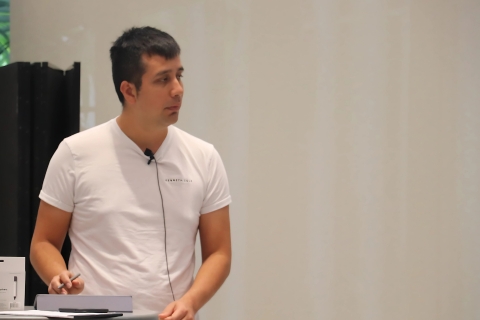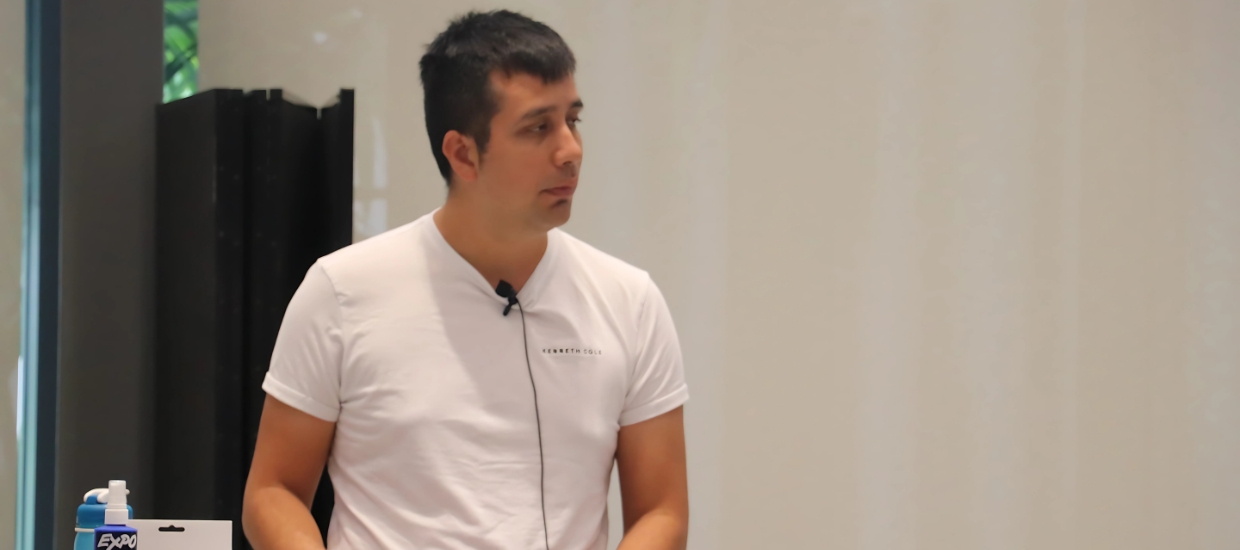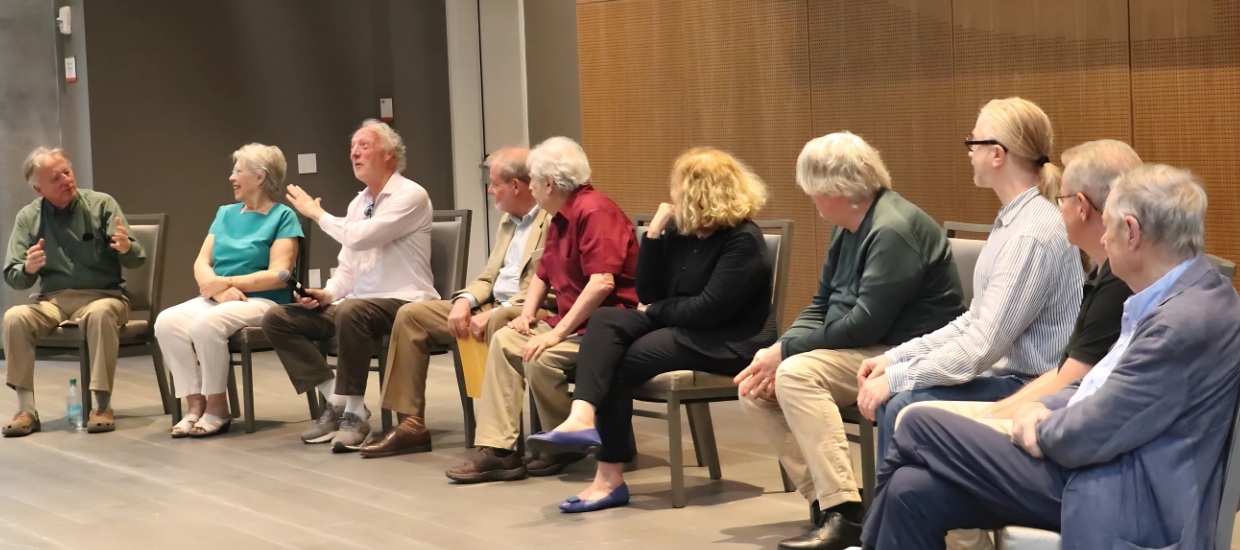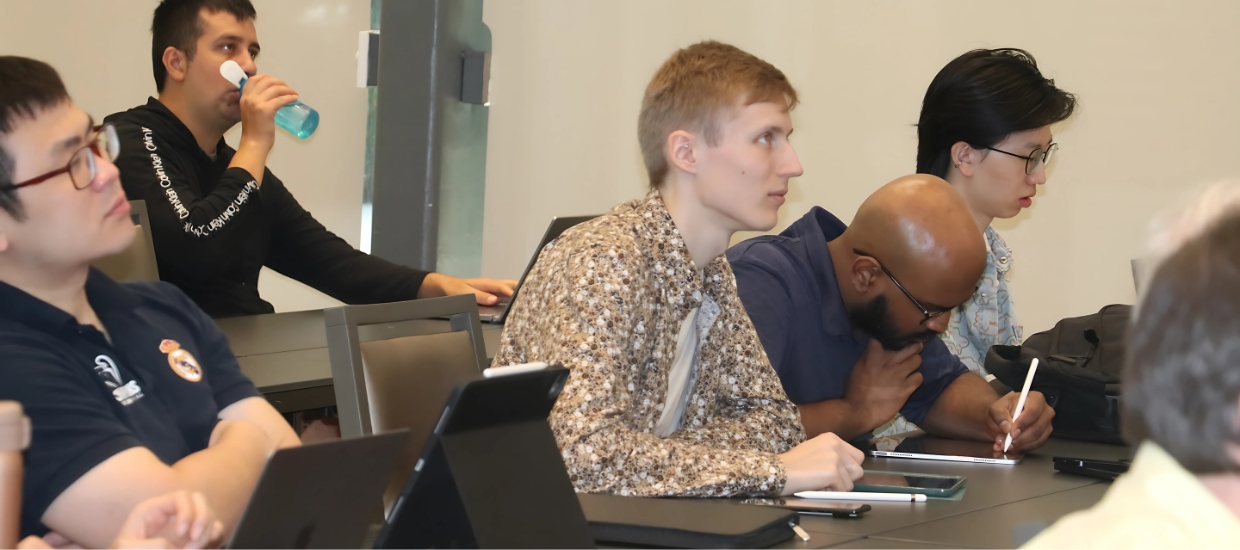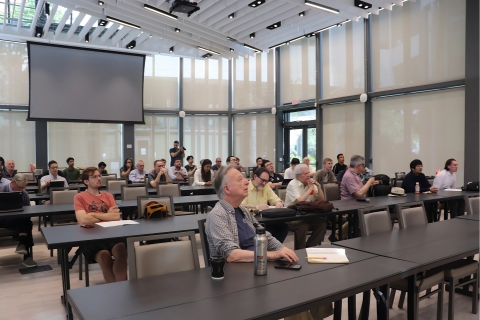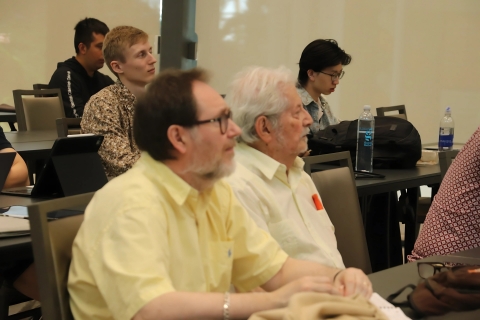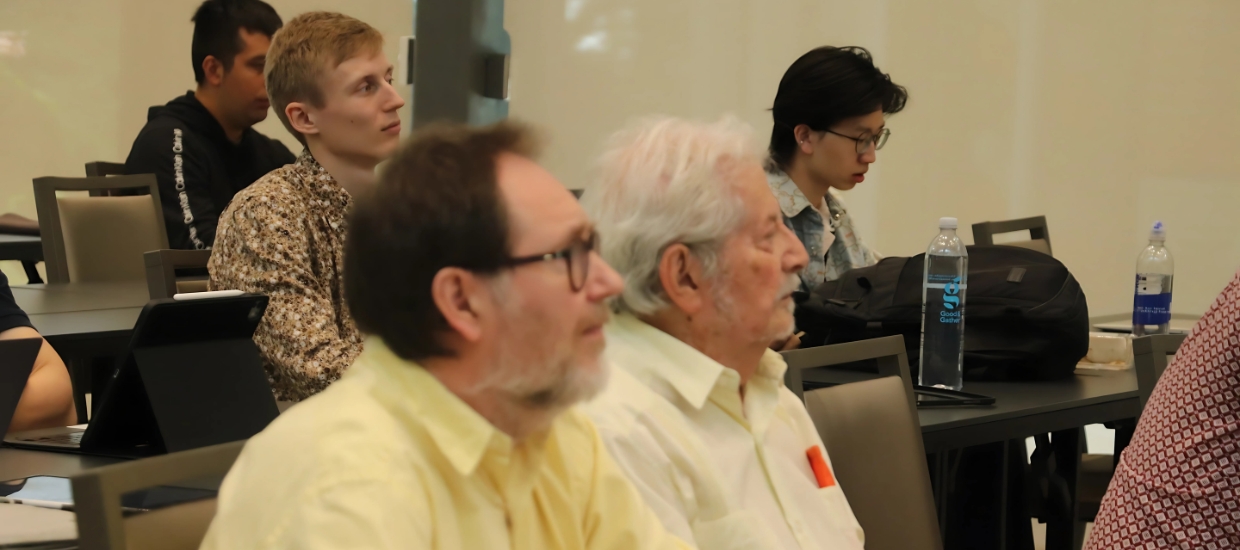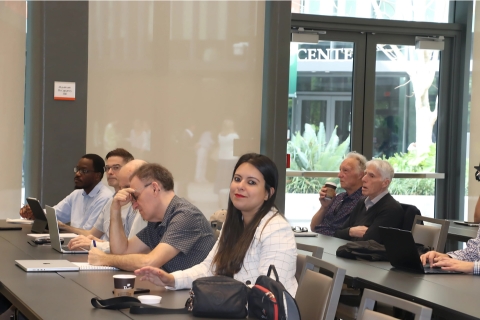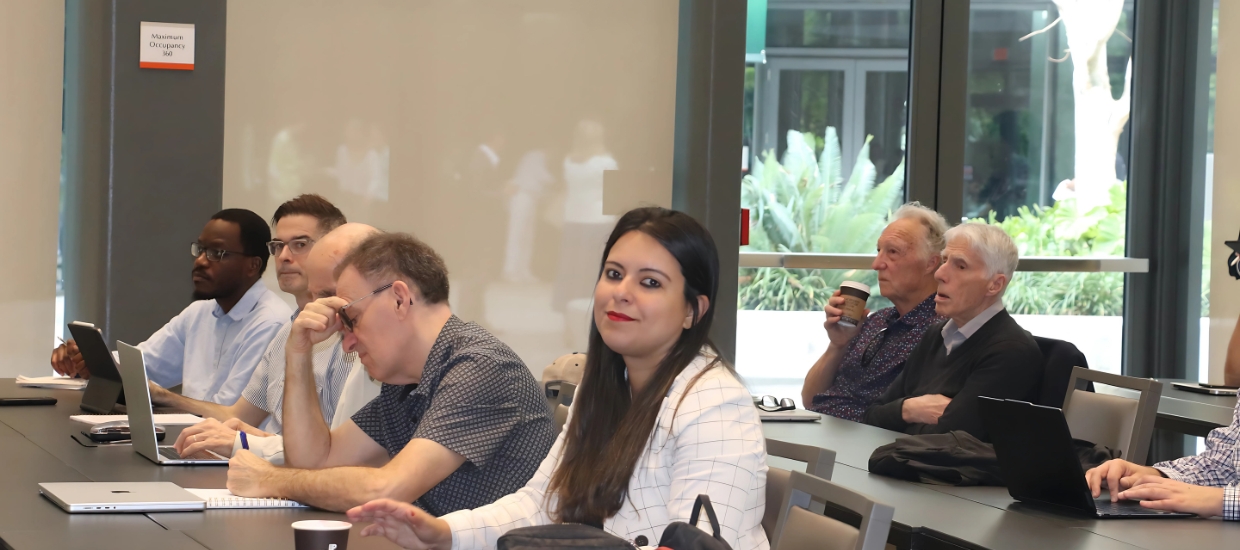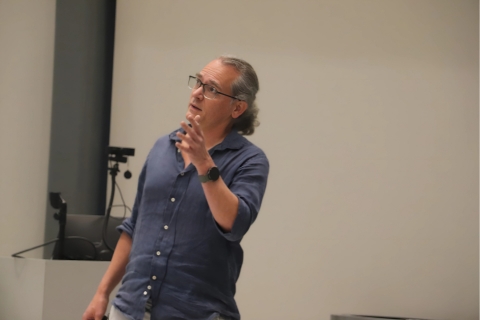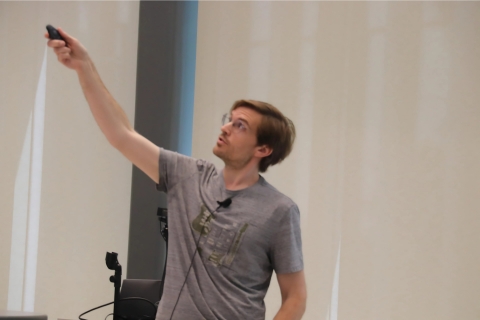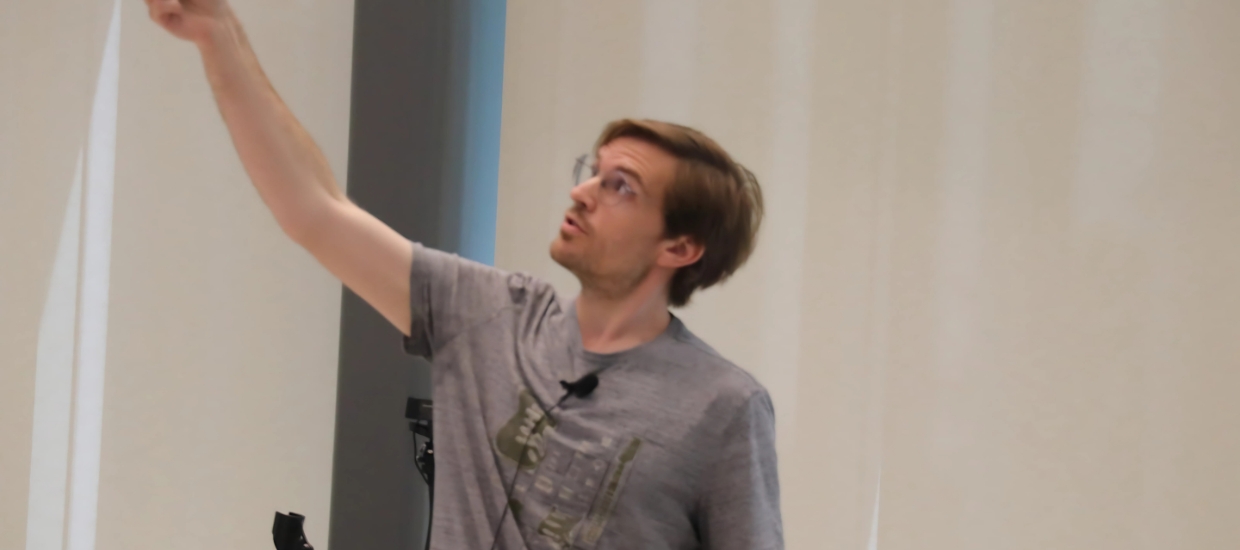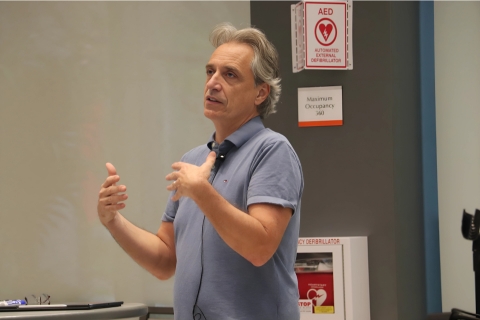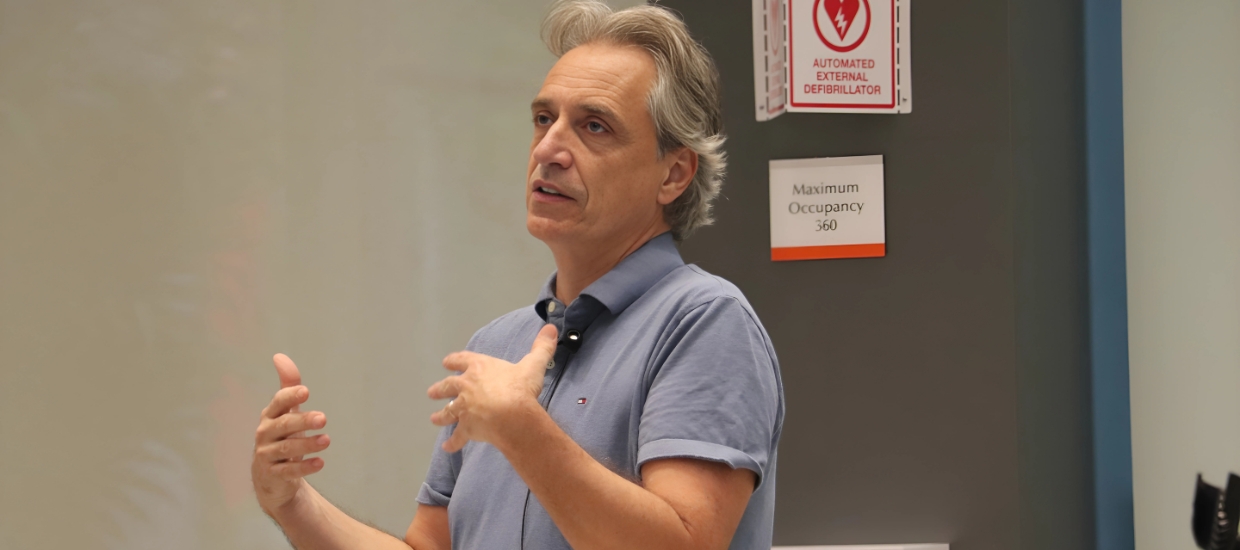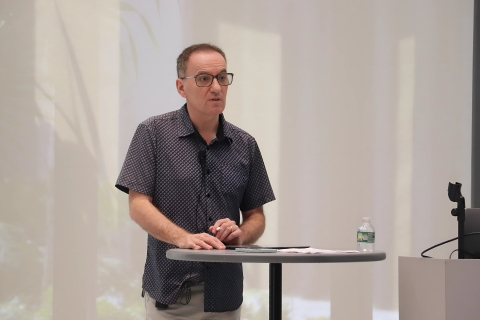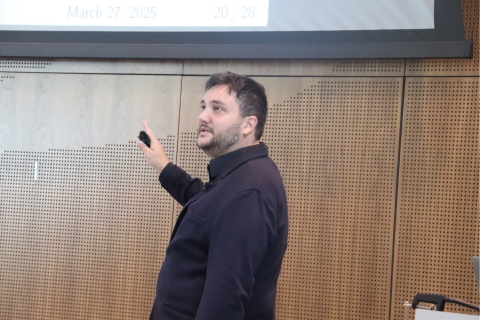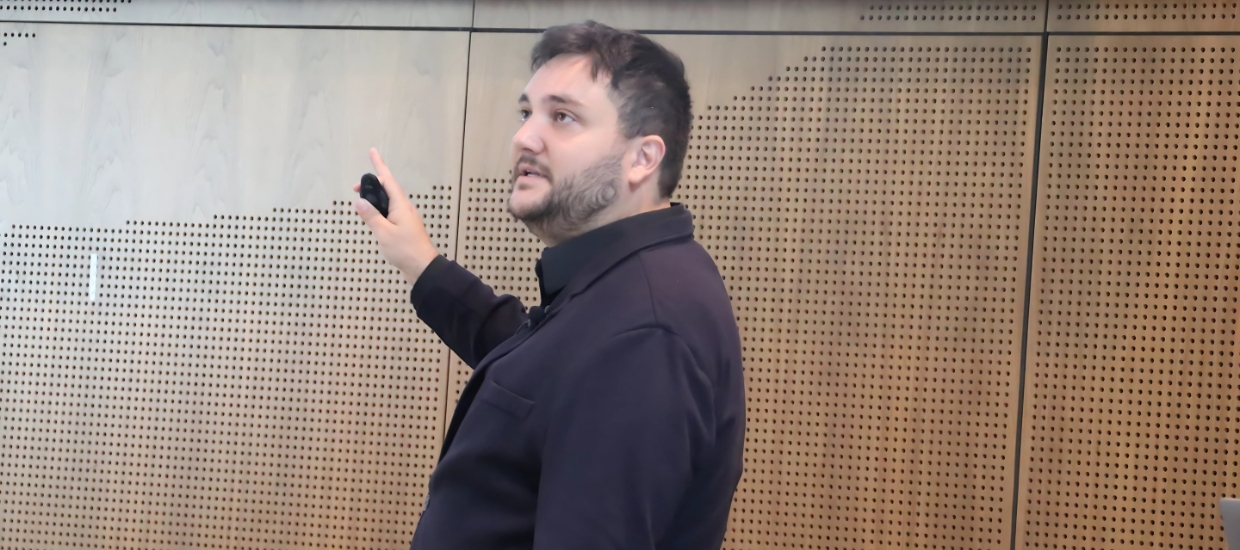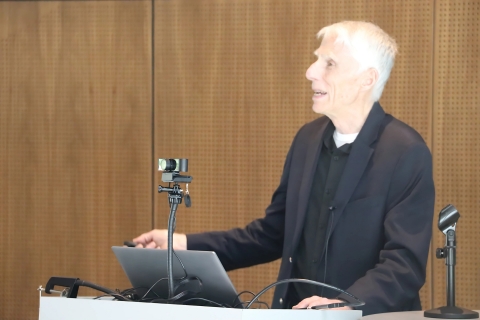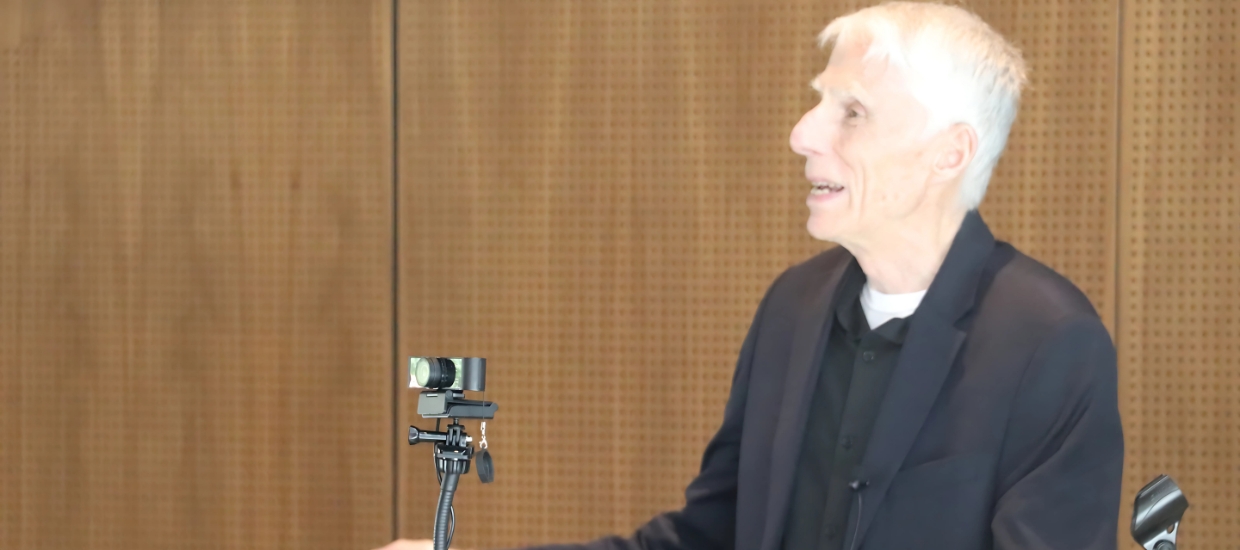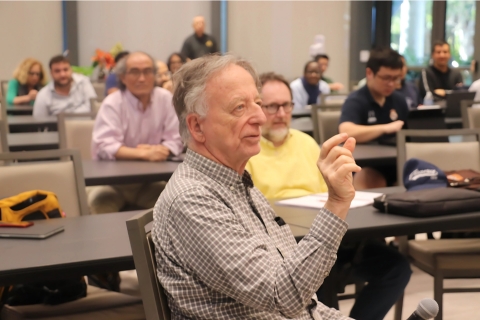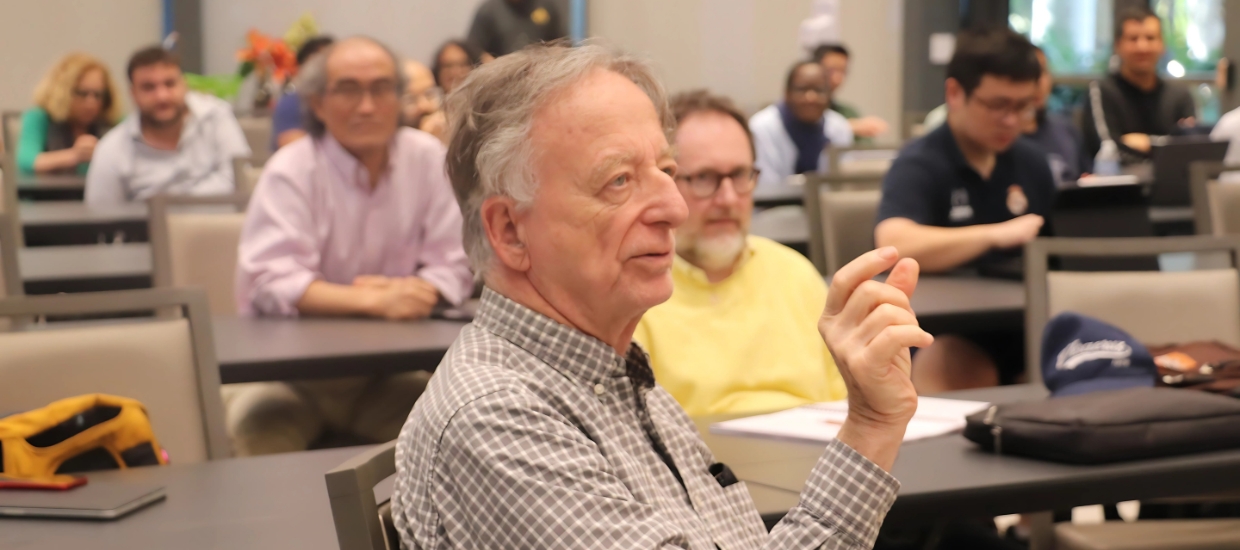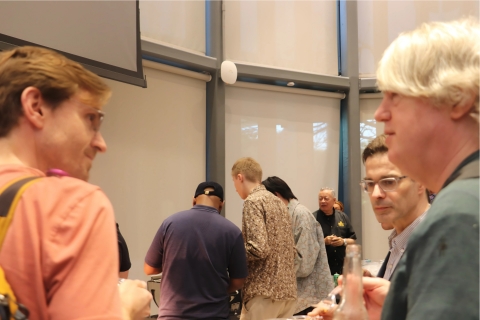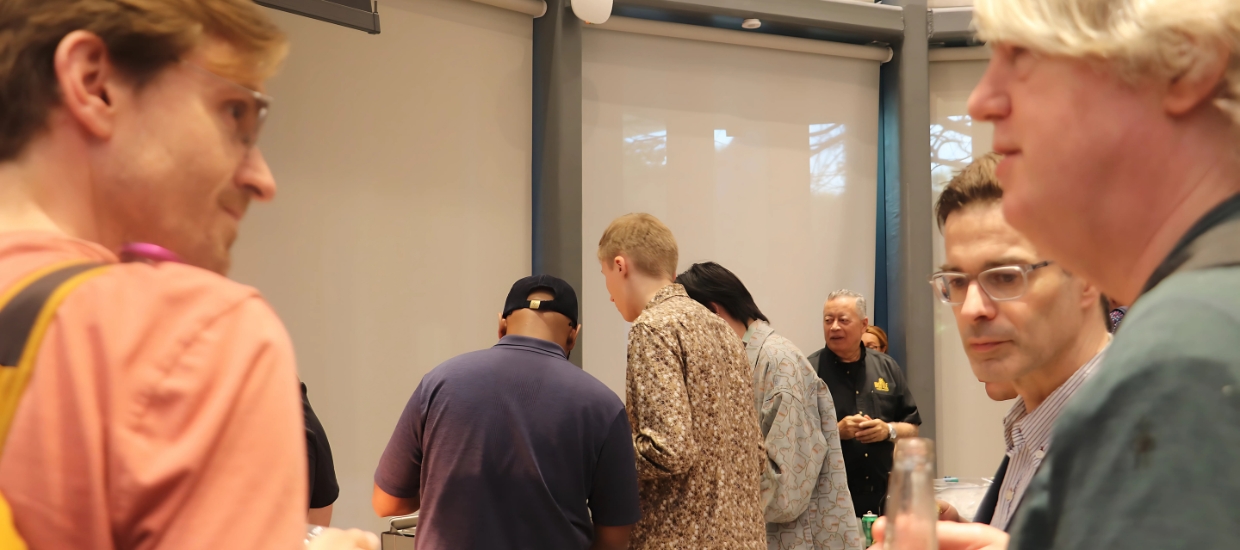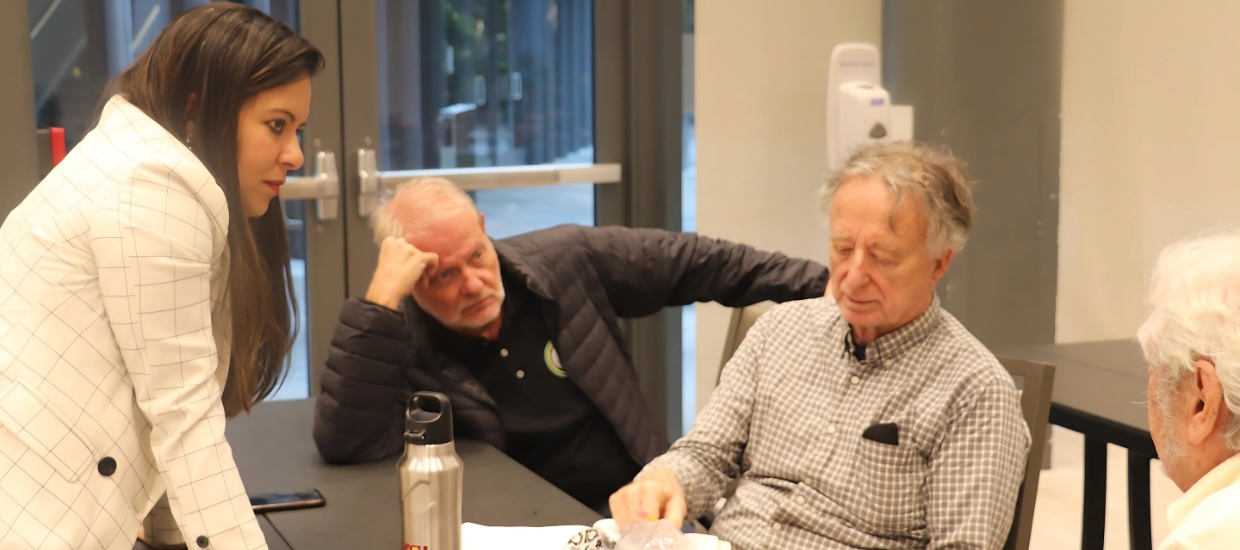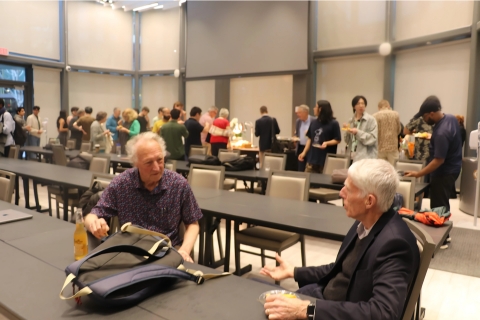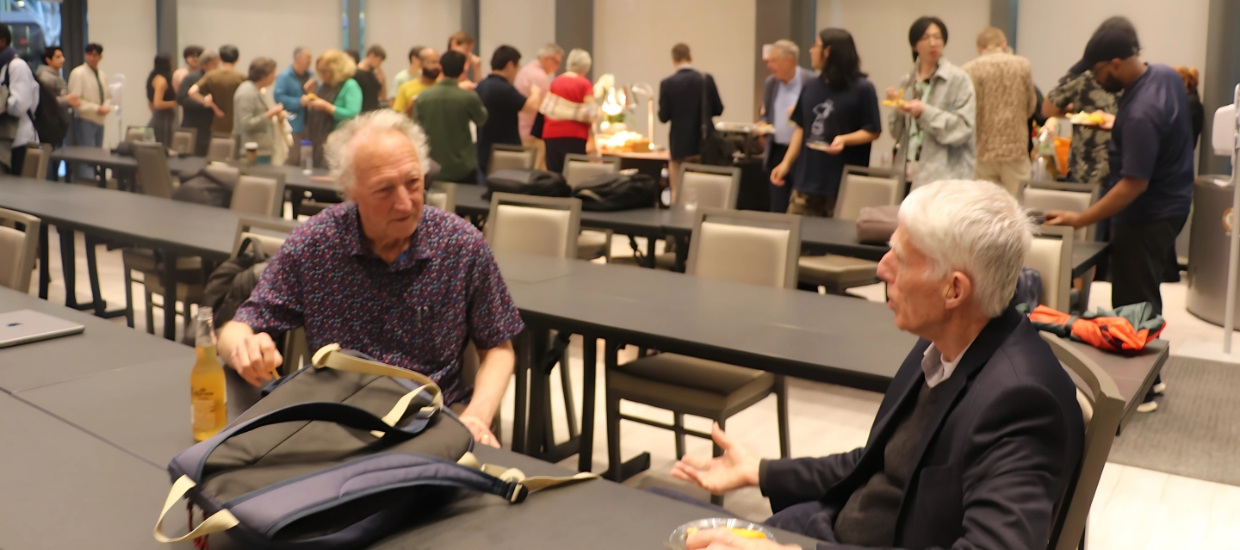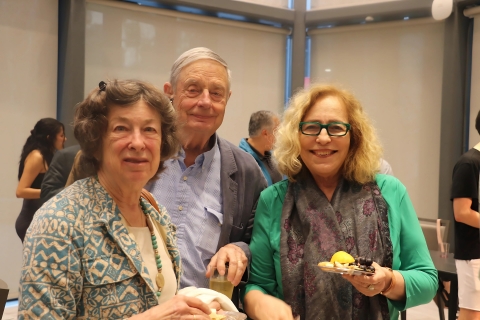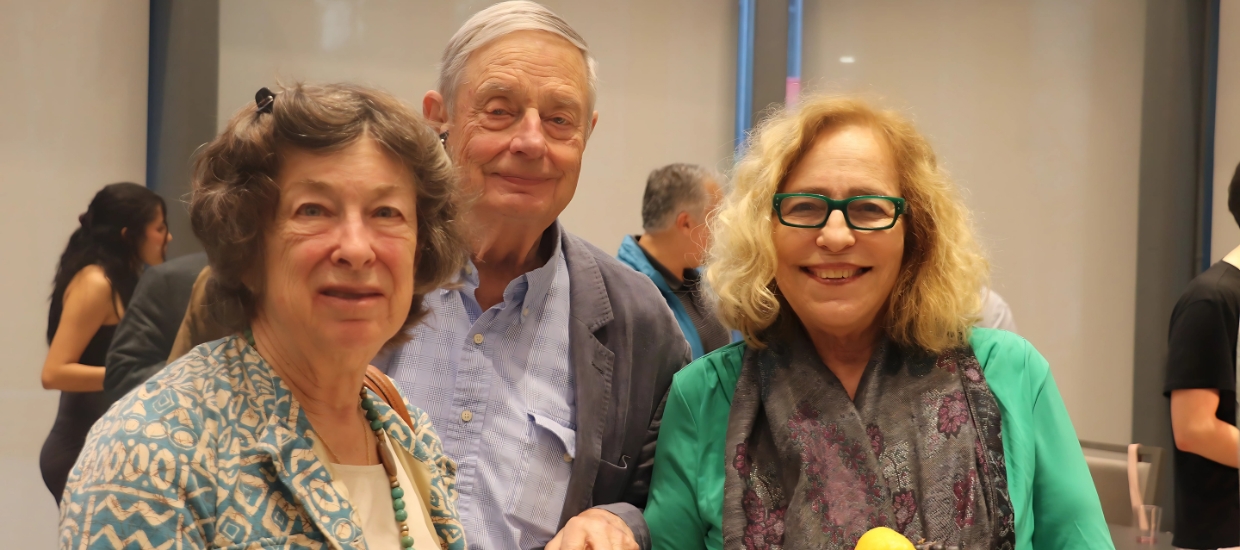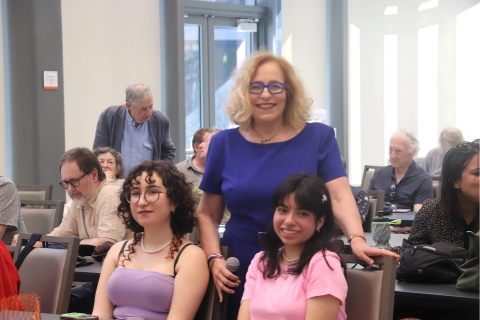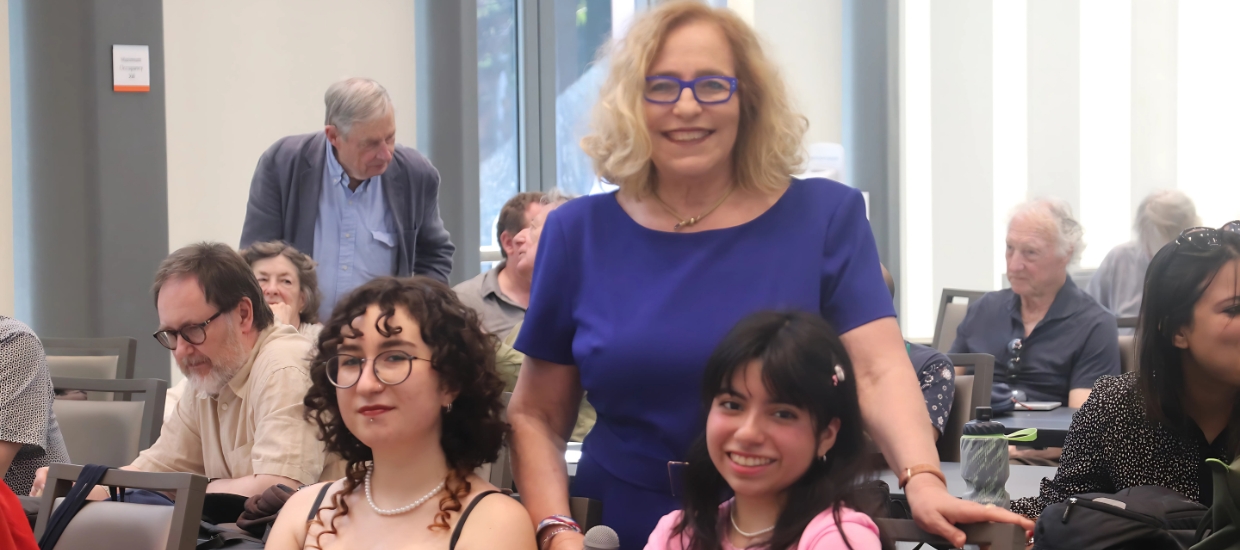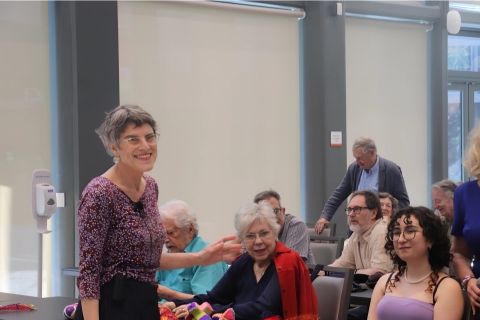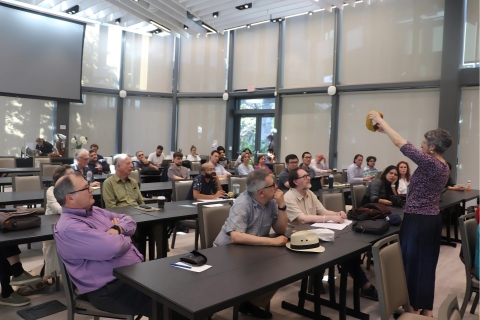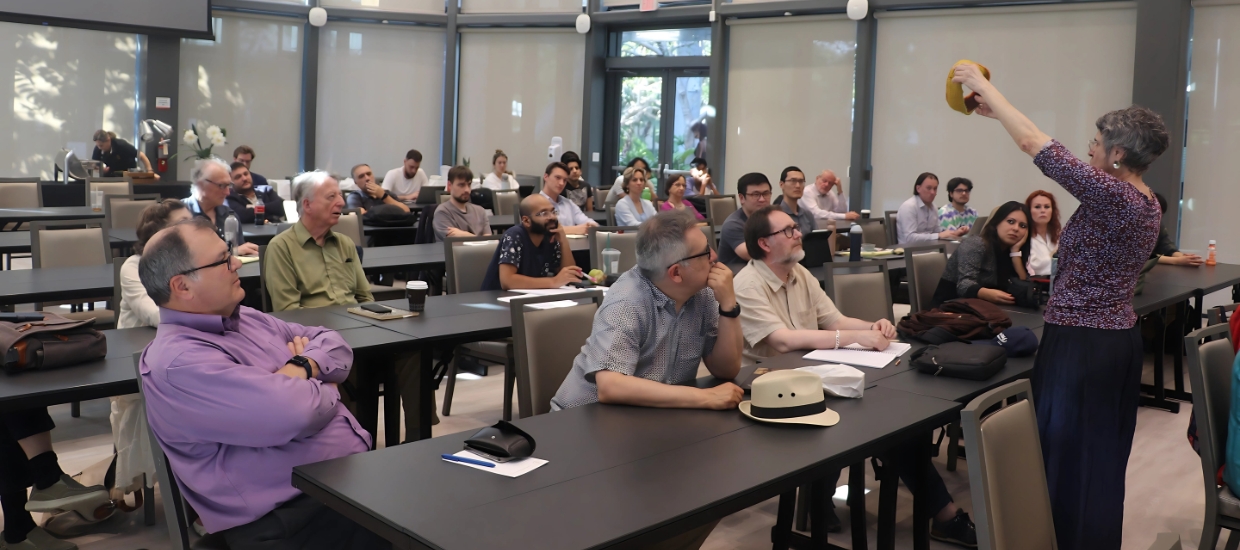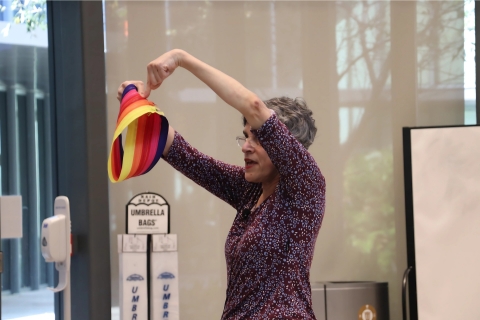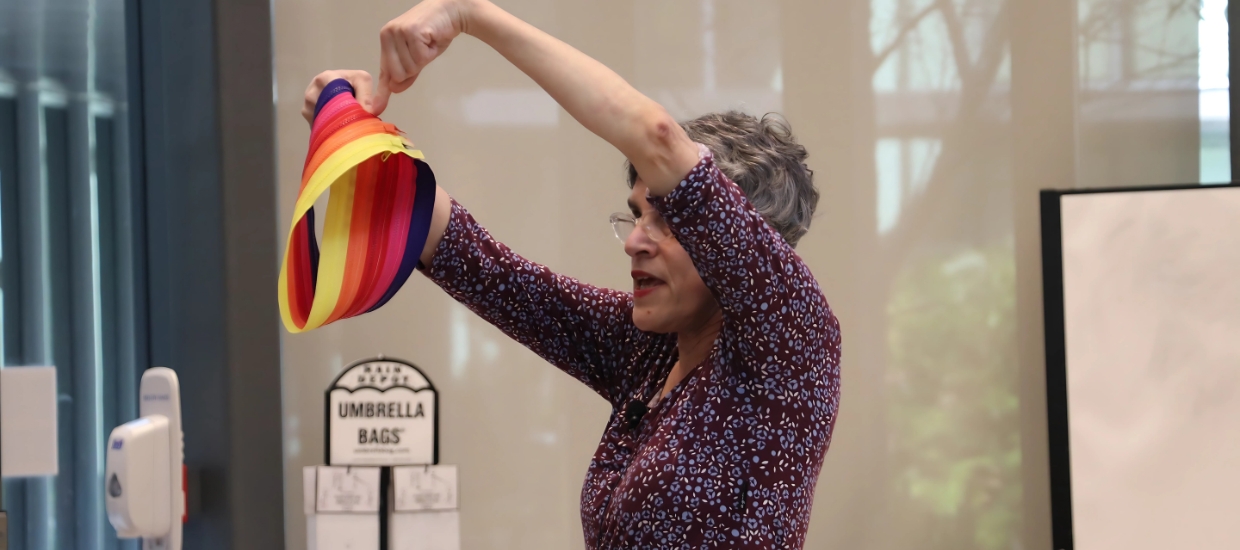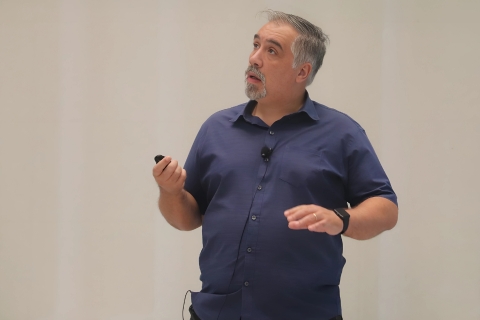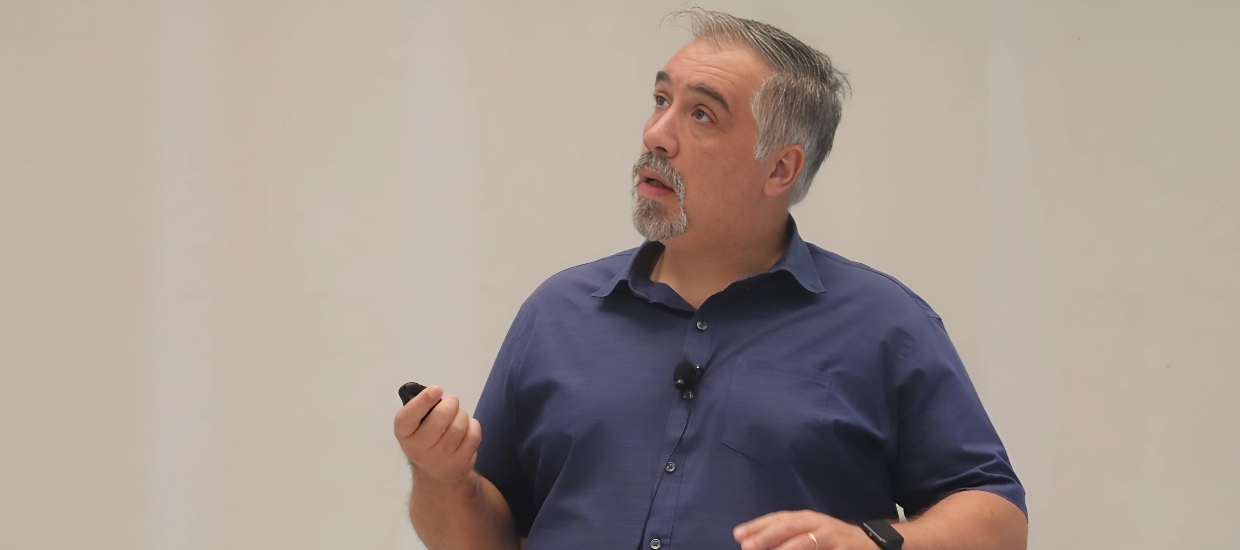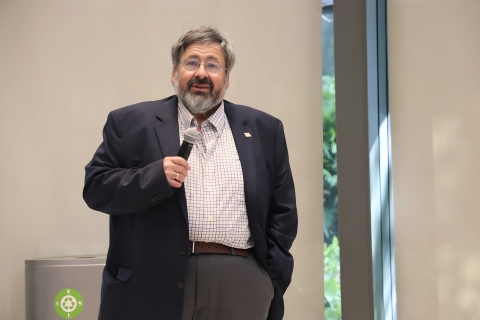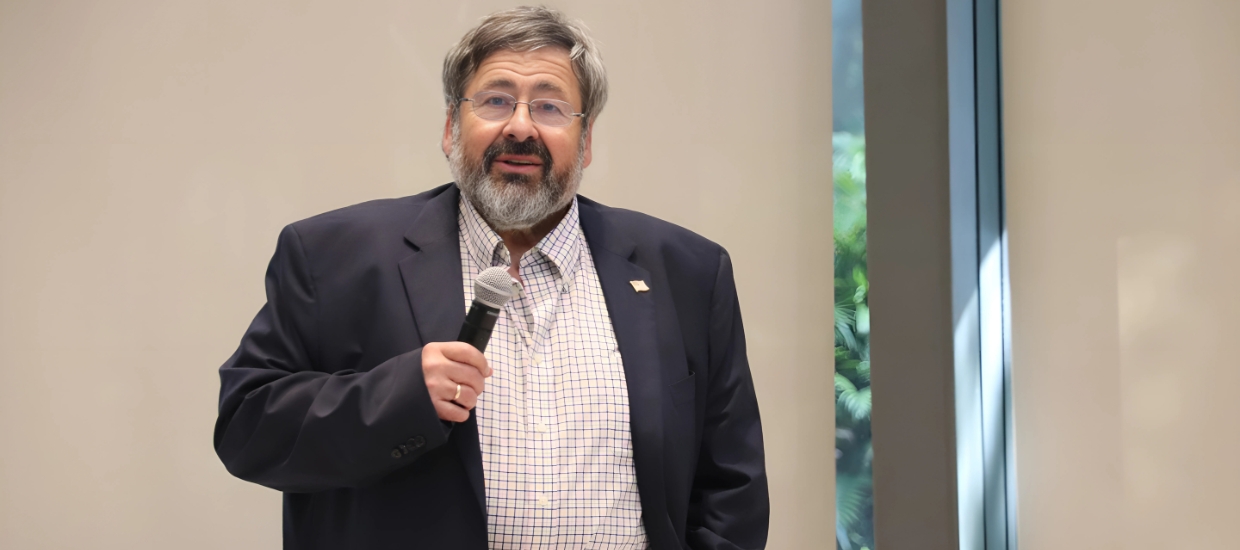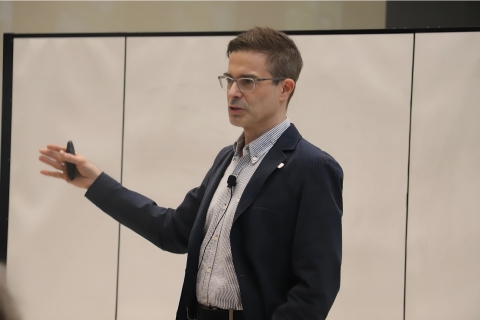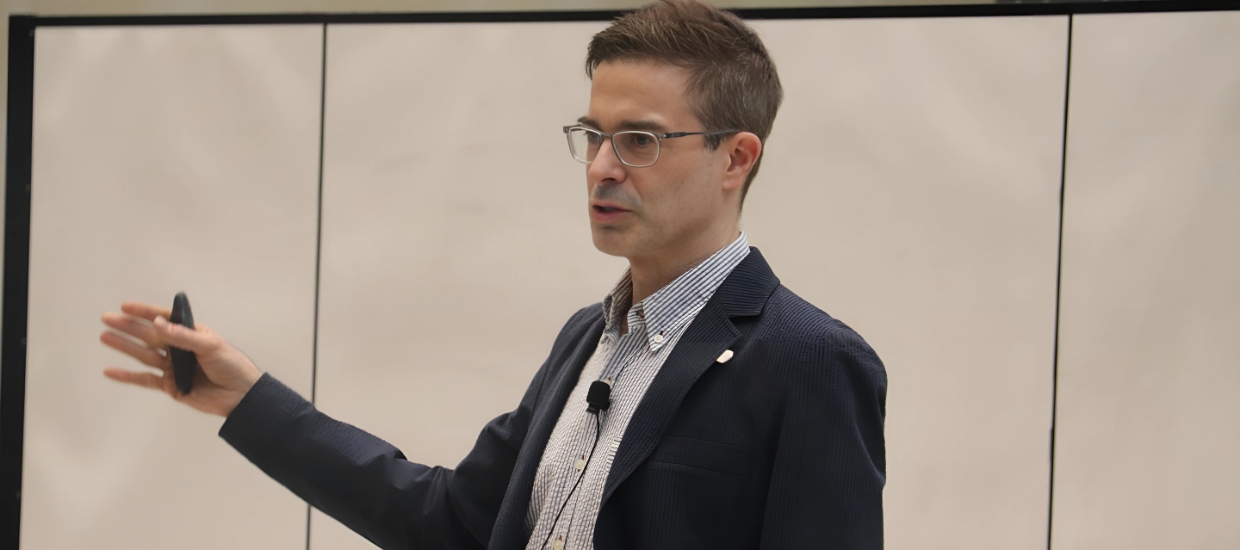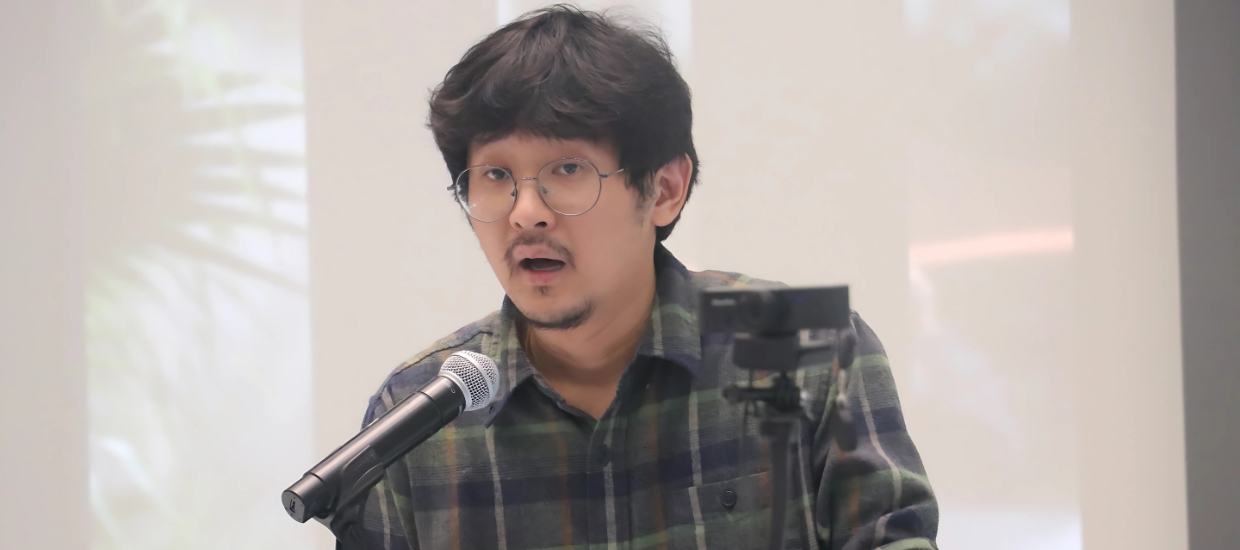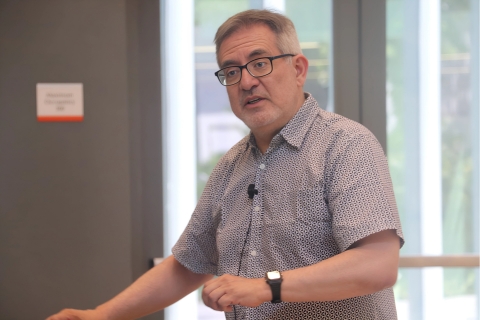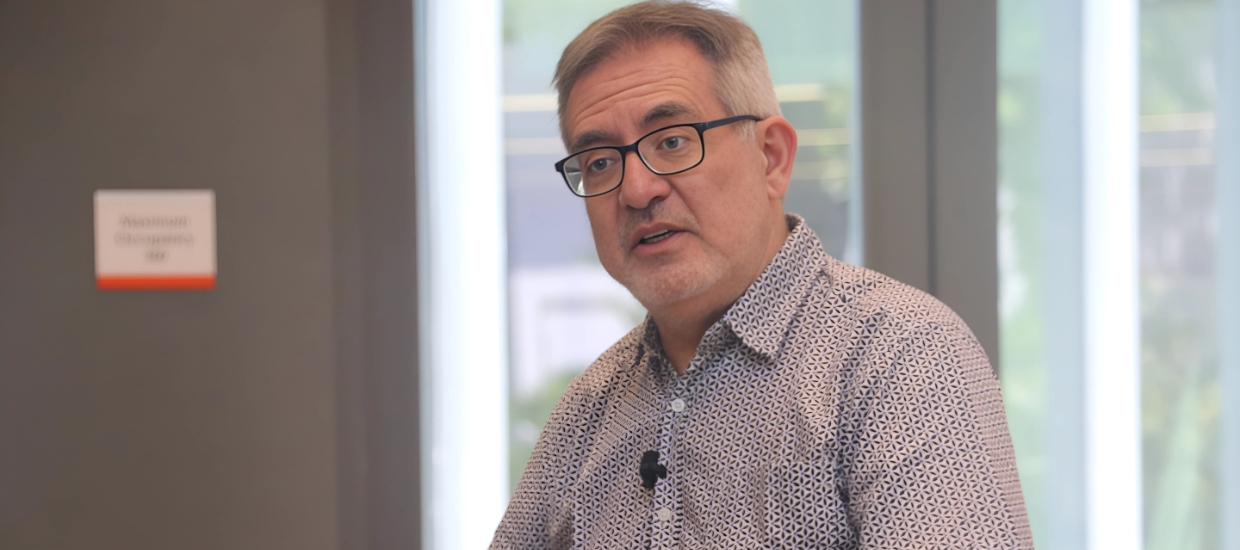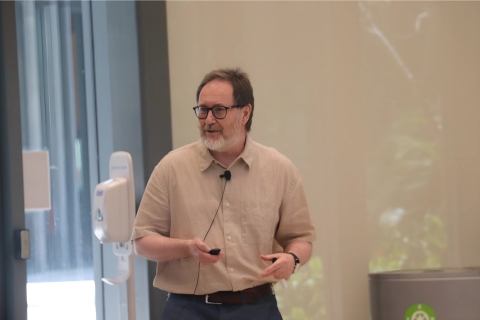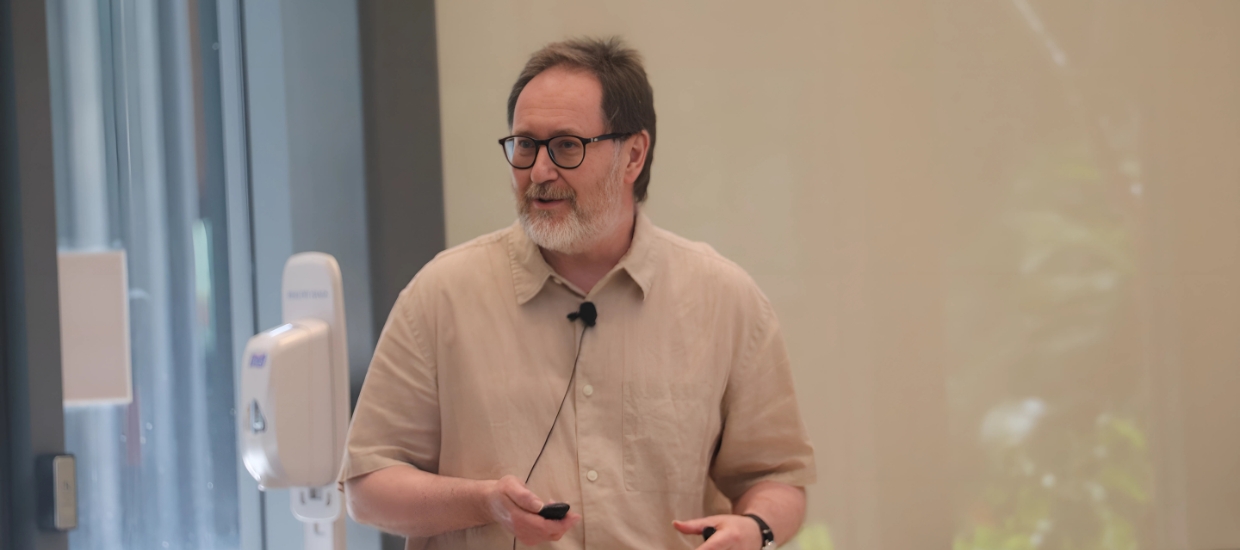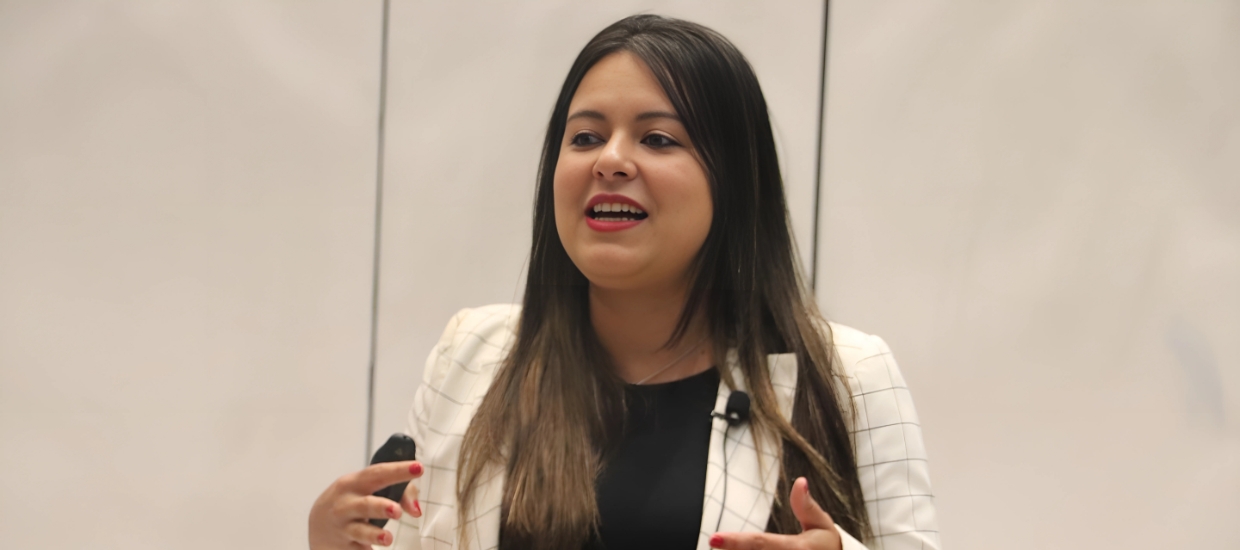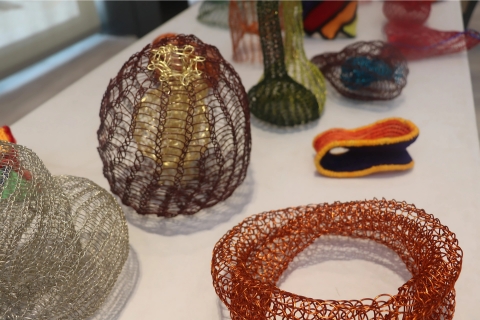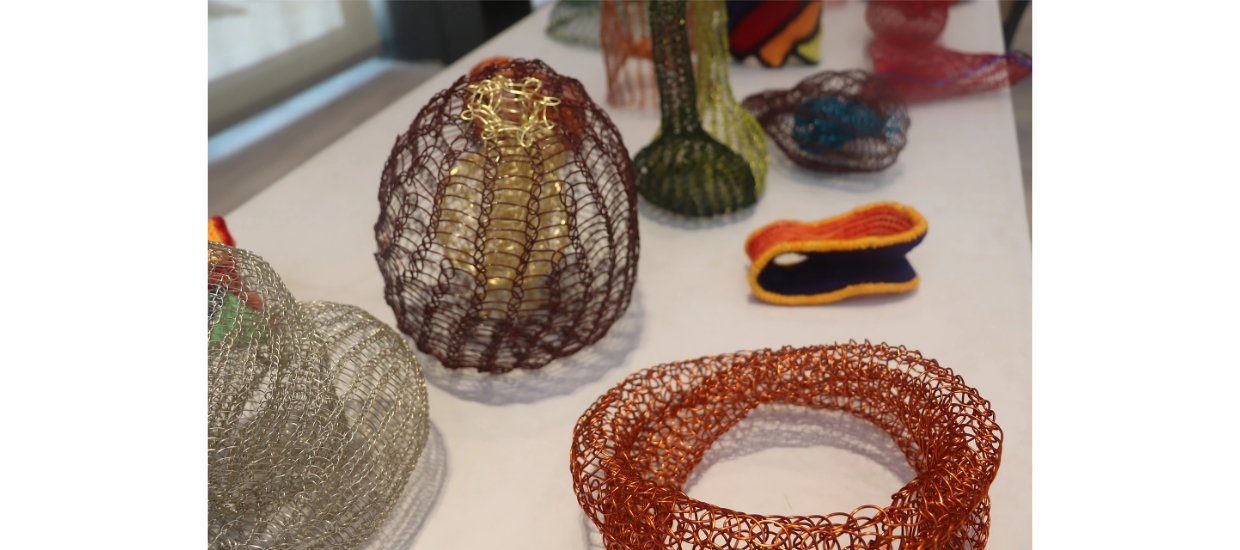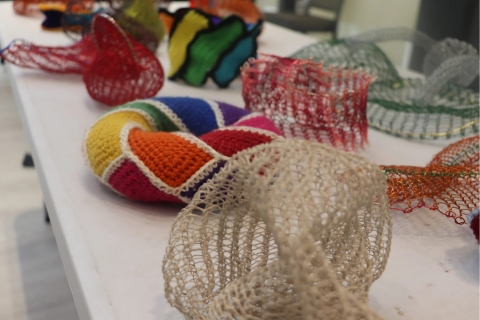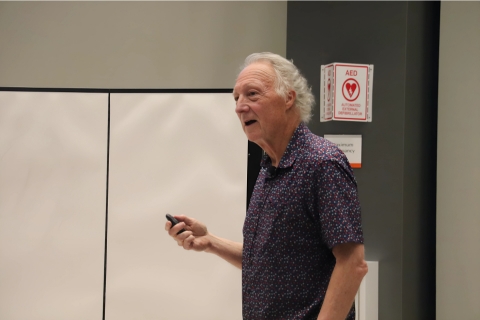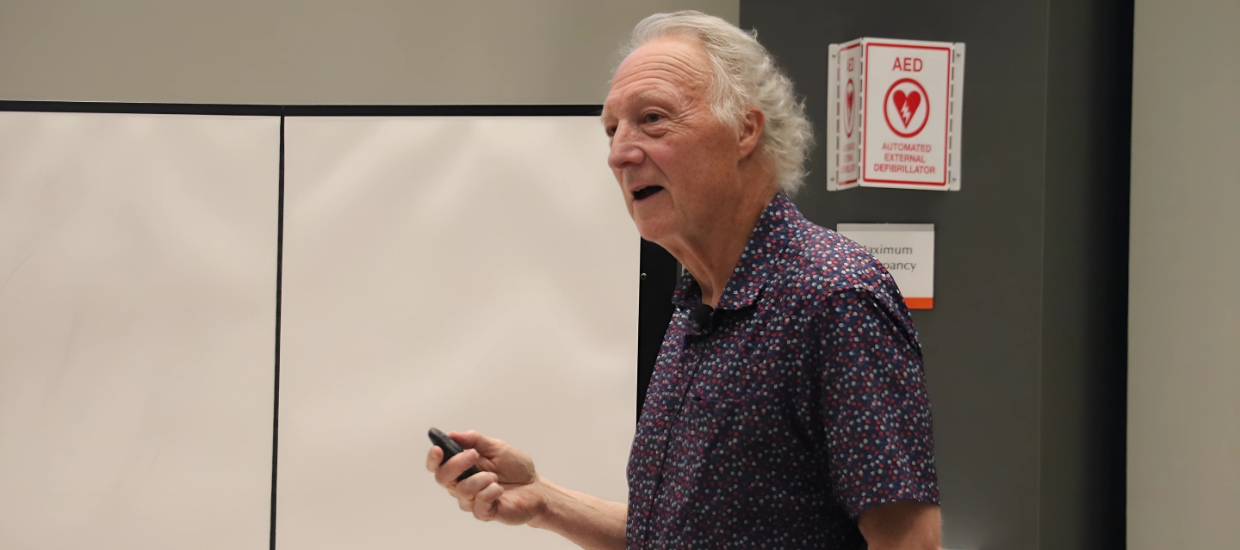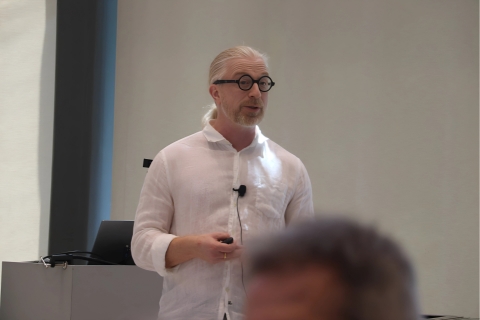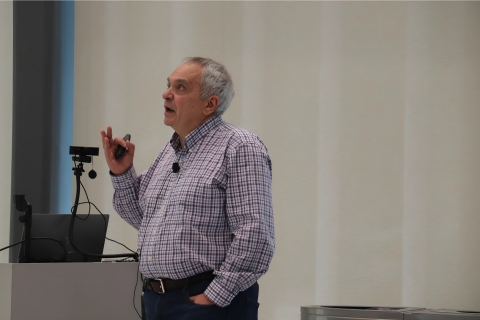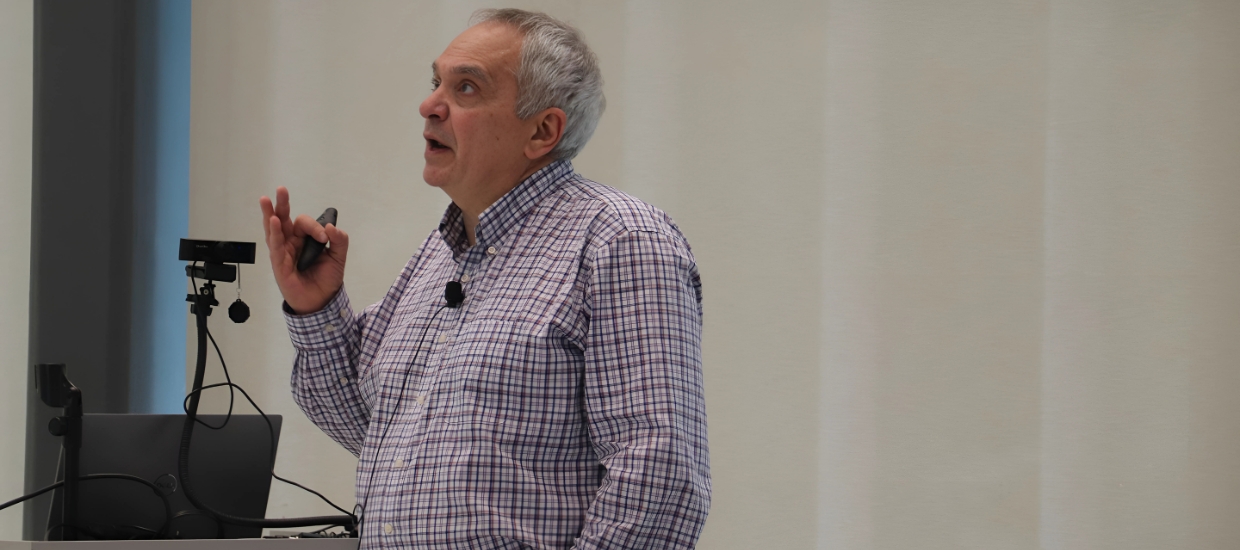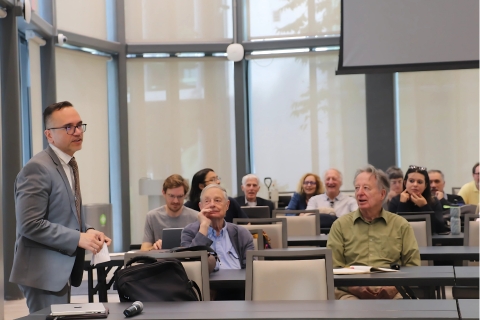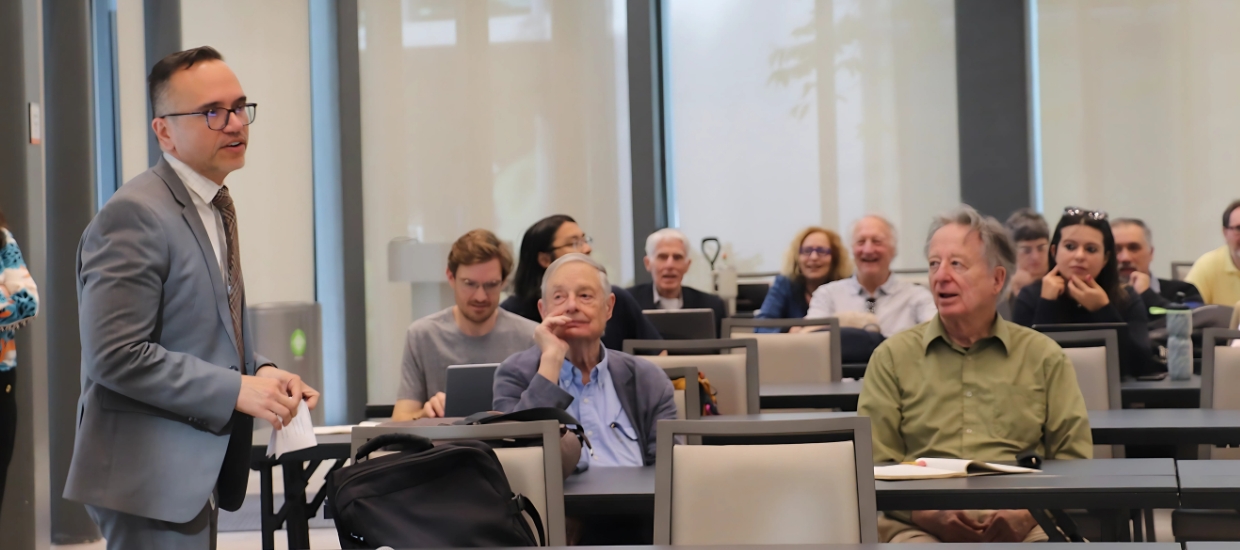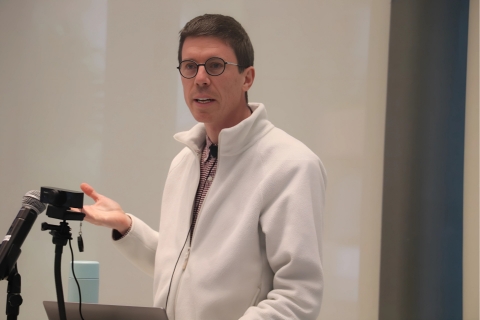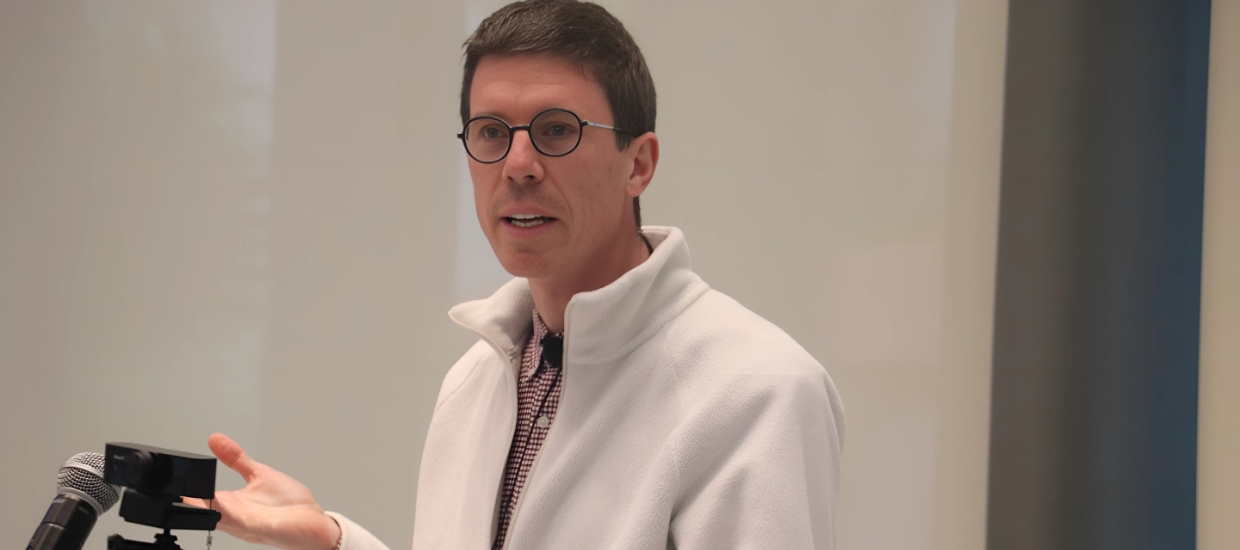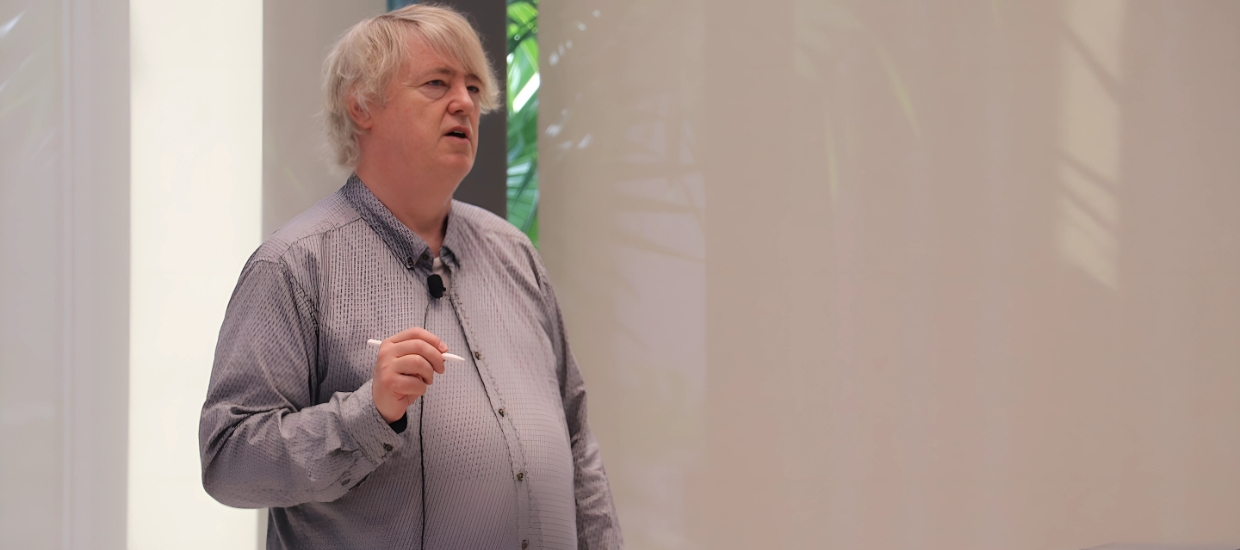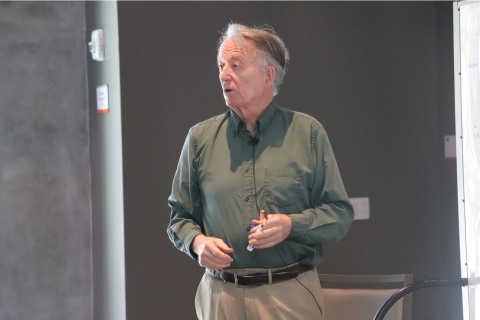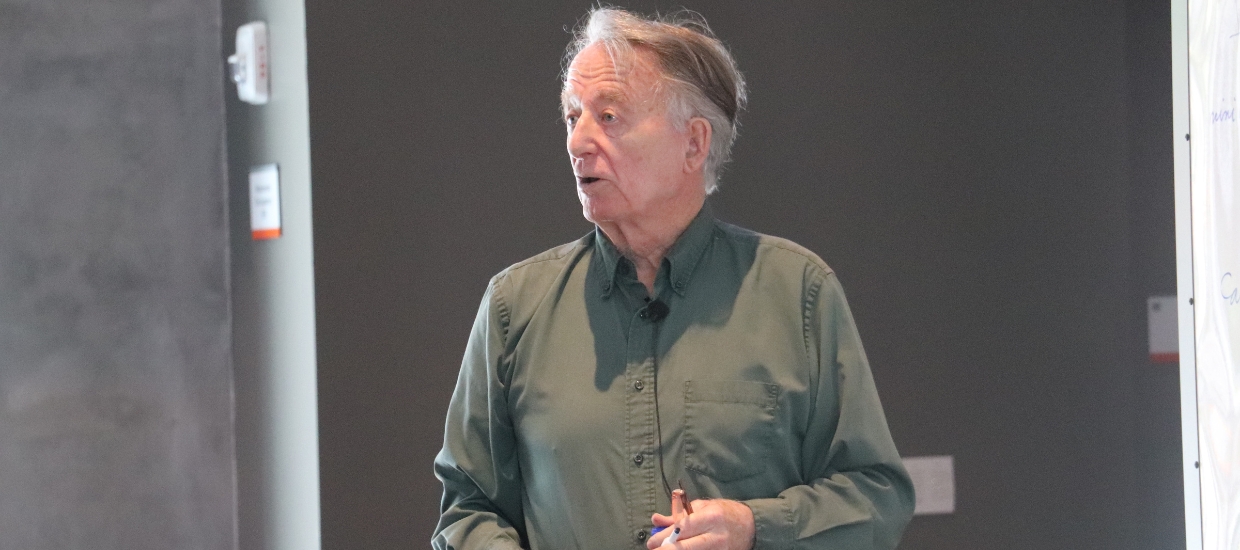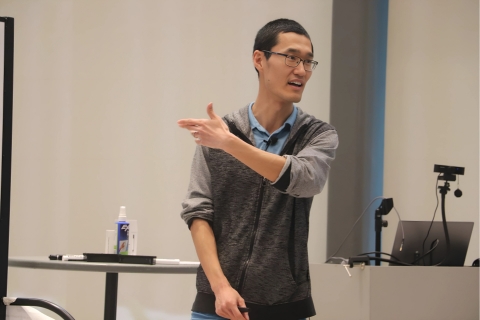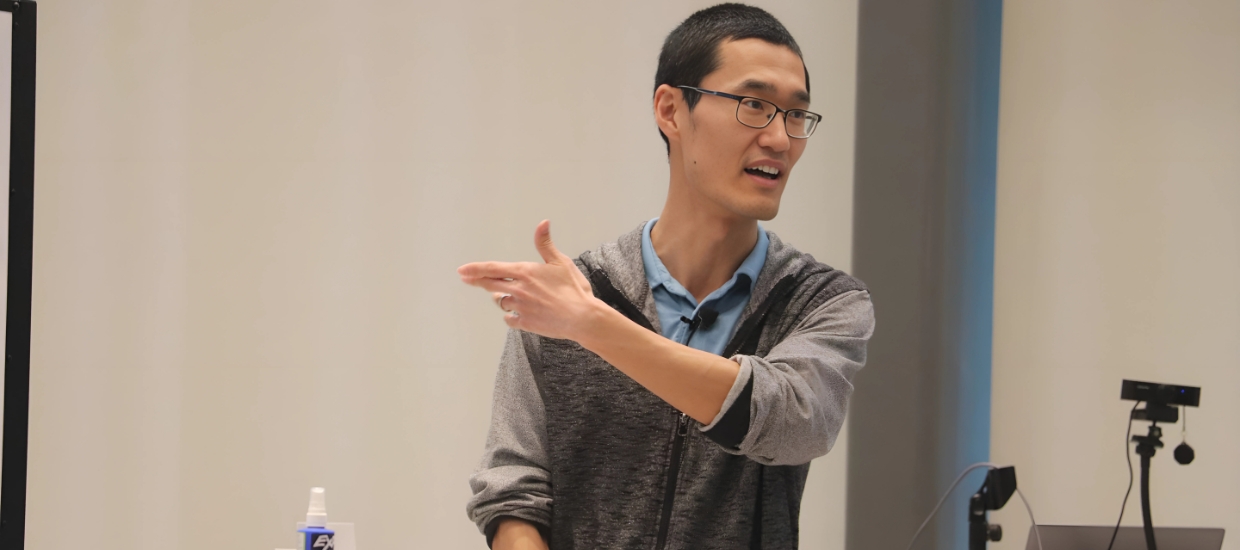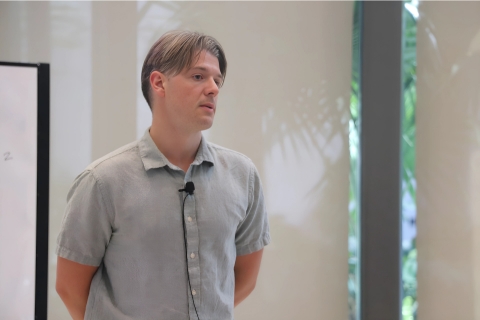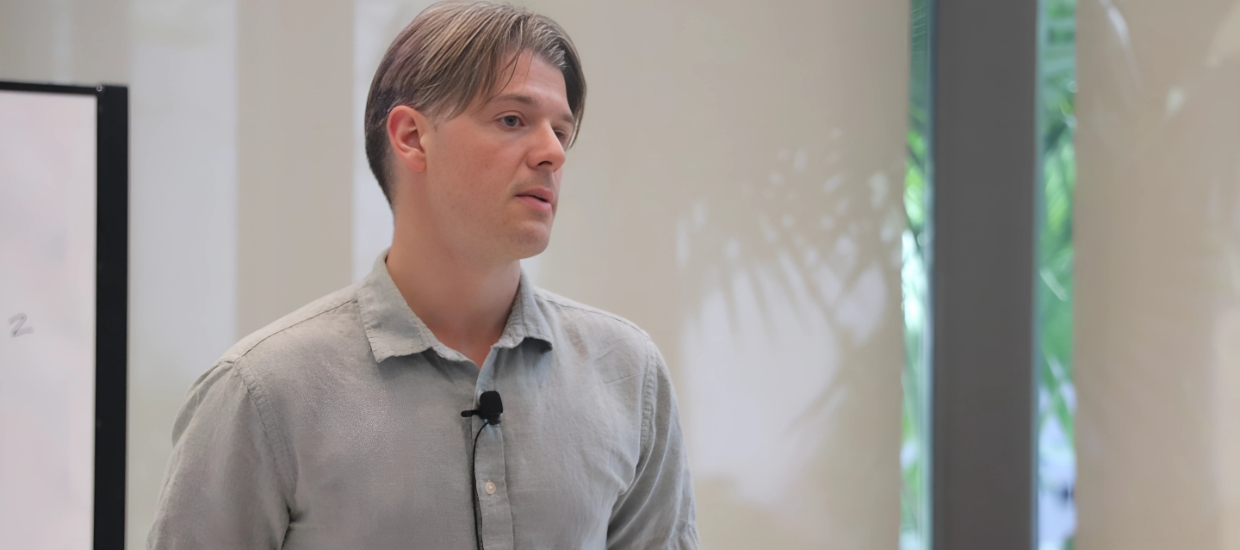Dates: March 24-29, 2025
Location: Lakeside Village Pavilion, 1280 Stanford Dr, Coral Gables, FL 33146
Live Video Available via Zoom
To register, please click here.
For the poster, click here.
IMSA is hosting a conference to honor Solomon Lefschetz, a pioneering mathematician whose work in algebraic topology, algebraic geometry, and differential equations has shaped modern mathematics. Lefschetz, who overcame adversity after losing both hands, made groundbreaking contributions that continue to influence the field. The event will bring together experts to discuss advancements in these areas and celebrate his enduring legacy.
Schedule
Monday, March 24, 2025
| 9:50am |
Opening
|
| 10:00am |
Carlos Simpson, University of Nice: Lefschetz devissage and Hodge theory Video
Lefschetz proposed the study of the topology of complex algebraic varieties and gave a general method revolving around families of hyperplane sections. The topological invariants of the hyperplane sections vary in local systems over the base projective space, with singularities along the discriminant divisor, and the monodromy representations encode topological data. The fundamental group of the complement of the discriminant divisor thus plays a major role. This led to Griffiths' notion of variation of Hodge structure. Following the basic study of asymptotic properties of degenerations by Griffiths, Schmid, Clemens, Steenbrink, Cattani, Kaplan, Kashiwara, Kawai, Deligne, Saito and others, Zucker's theorem explains how to integrate the VHS coming from the Lefschetz pencil, to the Hodge-theoretic information of the original complex structure. This was generalized by Saito. These theories are inputs to the notion of nonabelian Hodge correspondence. We'll explore some recent aspects.
|
| 11:30am |
Mark Andrea de Cataldo, Stony Brook: The decomposition theorem for the logarithmic Hitchin fibration Video
I will report on ongoing joint work with Andres Fernadez Herrero, Roberto Fringuelli and Mirko Mauri on the moduli space of semistable logarithmic principal G-Higgs bundles on a smooth curve. For any given degree d in the algebraic fundamental group of G, we exhibit a uniform description of the decomposition theorem for the corresponding Hitchin fibration of degree d logarithmic G-Higgs bundles.
|
| 2:00pm |
Alberto Verjovsky, UNAM: Adelic loop groups Video
Loop groups have been fundamental tools in geometry and mathematical physics. In this talk I survey a generalization that uses ideas from Dynamical systems and number theory: the adelic loop groups.
|
| 3:15pm |
Bruno Klingler, Humboldt Universität zu Berlin: Around the Zilber-Pink conjecture (Zoom) Video
The Zilber-Pink conjecture describes the Hodge locus of subvarieties of Shimura varieties, and more generally the Hodge locus of any variation of Hodge structure. In this talk I will review recent progress towards this conjecture (based on past work with Baldi and Ullmo, work of Baldi-Urbanik, and work in progress with Tayou).
|
| 4:30pm |
Benjamin Bakker, University of Illinois Chicago: The linear Shafarevich conjecture for quasiprojective varieties Video
Shafarevich asked whether the universal cover of a smooth projective variety X is always holomorphically convex, meaning it admits a proper map to a Stein space. This was proven in the linear case---namely when X admits an almost faithful representation of its fundamental
group---by Eyssidieux--Katzarkov--Pantev--Ramachandran using techniques from non-abelian Hodge theory. In joint work with Y. Brunebarbe and J. Tsimerman, we prove a version of the linear Shafarevich conjecture for quasiprojective varieties. The proof relies on a number of recent advances in non-abelian Hodge theory in the non-proper case, and we will focus on the role played by the twistor geometry of the stack of local systems.
|
Tuesday, March 25, 2025
| 10:00am |
Ludmil Katzarkov, UMiami: Introduction to atoms Video
We will explain how theory of atoms originates from combining A and B sides of Homological Mirror Symmetry. Examples will be considered.
|
| 11:30am |
Tony Pantev, UPenn: Theory of atoms and applications Video
We will give a proof of nonrationality of generic 4 dim cubic.
|
| 2:30pm |
John Morgan, Columbia University: Poincare/Lefschetz Duality Bordism Theory Video
Given a cohomology theory $J$, one way to study it Is to find a class of `cycles’ on which the theory has numerical invariants and show that an class $\xi\in J(X)$ is determined by the invariants of $\xi$ on all cycles mapping to $X$. The strongest form of this paradigm is when the cycles are the closed objects of a bordism theory which is Anderson dual to the given cohomology theory. We shall give several simple examples of this paradigm, eg., ordinary cohomology and pseudo-manifolds and complex K-theory and a quotient of almost complex bordism. The main point of the talk will be to use Intersection cohomology to construct a bordism theory that is dual to the basic cohomology theory of surgery
|
| 3:35pm |
Ken Baker, University of Miami: Morse-Novikov numbers of 3-manifolds Video
The Morse-Novikov number of a homotopy class of circle valued functions on a 3-manifold counts the minimum number of critical points among Morse representatives. Viewing circle valued Morse functions more coarsely as their associated handle decompositions, we recast this count as a 'handle number' and leverage the theories of generalized Heegaard splittings and sutured manifolds to advance our understanding of these counts. We will survey key results and curious phenomena developed and observed in our work and joint works with Fabiola Manjarrez-Gutierrez.
|
| 4:40pm |
Matt Kerr, Washington University in St. Louis: Two vignettes on hypergeometric regulators Video
Among the more explicitly computable examples of normal functions are those taking values in Jacobians of hypergeometric variations of Hodge structure. The goals of this talk are to (i) explain how such normal functions lead to number-theoretic identities of a type recently considered by Guillera, and (ii) to give a short proof of a conjecture of Golyshev on algebraic hypergeometrics, aided by an argument in the spirit of Lefschetz’s (1,1) theorem.
|
| 5:45pm |
TWAS in IMSA: Jaqueline Mesquita, Universidad de Brasilia: General concept of periodicity for any time scales Video
In this talk, we will present a general concept of periodicity for any time scales and some applications.
|
| 6:45pm |
Reception
|
Wednesday, March 26, 2025
| 10:00am |
Claire Voisin, CNRS Institut de Mathématiques de Jussieu-Paris: Universally defined cycles (Zoom) Video
I introduce the notion of universally defined cycles (for smooth varieties of dimension d) and prove that any unversally defined cycle is given on generic fibers by a polynomial in the Chern classes, which can be seen as a higher dimensional version of the Franchetta conjecture. I will also give the motivation for the main definition and explain a conjectural extension of that result to universally defined cycles on powers of varieties of given dimension.
|
| 11:30am |
Laurent Meersseman, Université d’Angers, France: LVM manifolds and their Hodge numbers Video
|
| 2:00pm |
Ernesto Lupercio, CINVESTAV: From Quantum Toric Spaces to Motivic Rings Video
In this talk, I will trace a path from LVM manifolds to quantum toric spaces and their moduli, exploring their connections to sandpile groups and self-organization. This will lead to the motivation behind certain motivic rings. This is joint work with Katzarkov, Lee, and Meersseman, as well as with Verjovsky, and also Shkolnikov, and Kalinin.
|
| 3:30pm |
Kyoung Seog Lee, POSTECH: Motivic aspects of complex analytic geometry Video
The motivic nature of cohomology rings of algebraic varieties is one of the key tools to study algebraic varieties. In this talk, I will discuss how to study various motivic aspects of cohomology rings of complex analytic varieties via o-minimal geometry. This talk is based on joint works with Ludmil Katzarkov, Ernesto Lupercio and Laurent Meersseman.
|
| 4:45pm |
Frontiers Lecture: Moira Chas, Stony Brook University Video
|
| 5:40pm |
Reception
|
Thursday, March 27, 2025, Lakeside Auditorium
| 10:00am |
Leonardo Cavenaghi, IMECC, UM: Atoms meet symbols Video
We present some new $\mathbb Z$-values $G$-birational invariants in dimensions 2 and 3, where $G$ is a $p$-cyclic group acting by regular automorphisms on smooth projective varieties $X$.
These are obtained from the modular symbol construction due to Kontsevich-Pestun-Tschinkel and the theory of atoms due to Katzarkov-Kontsevich-Pantev-Yu now extended to the $G$-equivariant setting. Time permitting, we present a 4-dimensional conjectural statement beyond whose proof escapes the existing technology. We use it to present an application in dimension 4. This is based on a joint work with L. Grama, L. Katzarkov, and M. Kontsevich.
|
| 11:30am |
Dennis Sullivan, Stony Brook University: 3D fluid motion Video
The vorticity is the curl of the velocity field in a 3D fluid motion. The vorticity as a vector field transports forward in time and is diffused by Brownian motion. One can study the distortion of the geometry and obtain apriori bounds using ideas based on cartan symmetric spaces.
|
| 2:00pm |
Herb Clemens, Ohio State University: String theory as applied (very classical) algebraic geometry Video
We suggest that `most' of necessary algebro-geometric input for a rather elegant model for Heterotic/F-theory duality in String Theory is contained in two books:
Classical Algebraic Geometry: A Modern View, by Igor Dolgachev,
Cambridge University Press (2012)
and
Enriques Surfaces I, 2nd edition, by F. Cossec, I. Dolgachev et al.,
Springer Verlag (2025).
The properties that the string theorists want, 3-generation, one Higgs doublet, Z4 R-symmetry, no vector-like exotics, calculable candidates for Yukawa couplings for quarks, leptons, and neutrinos at points of maximal symmetry, are provided by Enriques surfaces with two 'completely symmetric points' over the 'most symmetric' one-parameter family of degree-2 del Pezzo surfaces. A key role is played by the Higgs line bundle that in our case is constructed from a syzygetic tetrad of bitangents. It is used to navigate the roots of E8 and the breaking of its symmetries to those of the Standard Model. Joint work with Stuart Raby.
|
| 3:30pm |
Moira Chas, Stony Brook University: From Lefschetz to String topology Video
The speaker began her mathematical career by applying Lefschetz’s fixed-point theorem to the dynamics of surfaces. She will discuss how this work led to the study of different aspects of curves on surfaces. More precisely, each free homotopy class of closed oriented curves on a Riemann surface determines three numbers: its minimal self-intersection number, its geometric length (in a given hyperbolic metric), and its word length with respect to a fixed minimal generating set of the fundamental group. These numbers, as well as the Goldman Lie bracket of two such classes, can be explicitly computed or approximated using computational methods. In this talk, we will explore these numbers, their relationships, their computational aspects, and how this line of research led to the discovery of String Topology.
|
| 4:30pm |
Remembering Lefschetz Presentation
4:35 pm - IMSA Movie
4:50 pm - Lefschetz movie
5:20 pm - Talk by Ernesto Lupercio
5:40 pm - Round Table: Carlos Aragão, Phillip Griffiths, Ernesto Lupercio, John Morgan, Nikolai Saveliev, Carlos Simpson, Dennis Sullivan, Mina Teicher, Alberto Verjovsky
|
| 6:45pm |
Reception & Performance at Lakeside Pavilion
|
Friday, March 28, 2025
| 10:00am |
Ron Donagi, UPenn: On the irrationality of intersections of quadrics Video
Lefschetz’s ideas of a century ago continue to shape and motivate modern geometry. We will survey some rationality and irrationality results in algebraic geometry, and relate them to non-commutative spaces. We wlll show that the natural nc-space attached to an intersection of three quadrics in P7 is truly non-commutative. Using the new theory of Hodge atoms, this implies that a very general intersection of three quadrics in P7 is not rational. Joint work with Tony Pantev.
|
| 11:30am |
Lino Grama, CAMPINAS: Milnor spheres via spherical T-duality and generalized log transform Video
We explore the interplay between Spherical T-duality, exotic spheres, and the generalized log transform, revealing new connections in geometric topology and complex geometry. Spherical T-duality generalizes classical T-duality by replacing the circle group $\mathrm{U}(1)$ with the 3-sphere $\mathrm{S}^3$ or $\mathrm{SU}(2)$, relating $\mathrm{SU}(2)$-bundles equipped with degree-7 cohomology cocycles. A striking class of examples involves the 7-dimensional homotopy spheres $\Sigma^7$, whose product with $\mathrm{S}^1$ exhibits distinct holomorphic structures under spherical T-duality, contrasting with classical Hopf manifolds such as $\mathrm{S}^3 \times \mathrm{S}^1$.
Building on this framework, we introduce the generalized log transform, extending classical 4-dimensional elliptic fibration techniques to higher dimensions. Applied to 8-dimensional homotopy Hopf manifolds, this approach reveals structural parallels with lower-dimensional cases, shedding light on singularities and complex structures. This is joint work with Leonardo Cavenaghi and Ludmil Katzarkov.
|
| 2:00pm |
Nikita Nekrasov, Stony Brook: "Towards Lefschetz thimbles in quantum field theory" I Video
In quantizing classical mechanical systems or classical field theories, one often sums over the classical trajectories as in localization formulas, but also takes into account the contributions of the “instanton gas”: a set of approximate solutions of the equations of motion. I will report on the attempts to alleviate some of the frustrations of this 40+ year-old approach by finding the honest solutions of equations of motion of the complexified systems. These ideas originate in the Bethe/gauge correspondence and the Ω-deformed B-model. The examples include algebraic integrable systems, from the abstract Hitchin systems to the well-studied anharmonic oscillator, and 1+1 dimensional sigma models, such as O(N) and CP^{N-1} model (based on the work with late Igor Krichever).
|
| 3:30pm |
Filip Zivanovic, Simons Center for Geometry and Physics: Curious filtration from the Floer theory and C*-actions Video
In a series of papers with Alexander Ritter, we construct a Floer-theory invariant called symplectic cohomology for open symplectic manifolds that admit pseudo-holomorphic C*-actions.
Out of this construction, we get a filtration on ordinary cohomology of these manifolds, which in practice is explicitly computable, using Morse-Bott-Floer spectral sequences. I will show concrete examples of this filtration for ADE resolutions and low-dimensional Higgs bundles. If time permits, I will mention the comparison with other known filtrations for the latter spaces.
|
| 4:45pm |
Christian Schnell, Stony Brook: Primitive cohomology and the tube mapping Video
I will talk about one of the first papers I wrote. It is about a topological construction, called the "tube mapping", that generates the primitive cohomology of a smooth projective variety from the monodromy action on its hyperplane sections. I learned about it from Herb Clemens, but it is the kind of thing that Lefschetz himself could have used.
|
| 5:45pm |
Nikita Nekrasov joint with Physics: Towards Lefschetz thimbles in quantum field theory" II Video
|
Saturday, March 29, 2025
| 9:30am |
Bruno de Oliveira, University of Miami: Geography of surfaces big cotangent bundle and singularity invariants Video
We introduce the canonical model singularities (CMS) criterion for bigness of the cotangent bundle for surfaces. The CMS-criterion for bigness involves invariants for canonical singularities that we describe and we give formulas for A_n singularities. The CMS-criterion leads to conjectures and some answers about the geography and the possible ratios $c_1^2/c_2$ of surfaces with big cotangent bundle. Two cases are naturally separated: regular and irregular surfaces. For regular surfaces we apply the CMS-criterion to show the existence of deformations of hypersurfaces in $\PP^3$ with big cotangent bundle for degree $d\ge 8$ and give an example of the regular surface with big cotangent bundle with ratio close to 1/5. For irregular surfaces we show that there are examples with ratio as close to 1/5 as possible. If time permits, we talk about ratios below 1/5.
|
| 10:45am |
Rodolfo Aguilar, IMSA: Calabi-Yau vs log Calabi-Yau threefolds Video
We will compare the Hodge theory and the geometry of smooth projective Calabi-Yau threefolds against quasi-projective threefolds obtained by removing a smooth anti-canonical K3 surface to a smooth projective Fano threefold. Focus will be centered around Yukawa cubics, curves and Abel-Jacobi maps. Joint work with Ph. Griffiths and M. Green.
|
| 12:00pm |
Enrique Becerra, IMSA: The stringy spectrum of orbifolds Video
In this talk, I will introduce the stringy spectrum of orbifolds and state its basic properties. Roughly speaking, this is a motivic measure of orbifolds inspired in the classical Steenbrink spectrum of isolated hypersurface singularities.
|
| 1:10pm |
Yilong Zhang, Purdue University: Correspondence between elliptic-elliptic surfaces and K3 surfaces Video
An elliptic-elliptic surface is an elliptic surface over a genus one curve and has p_g=1. Its H^2 carries a K3-type Hodge structure, which is isometric to a Hodge substructure of a K3 surface with an E8 polarization. Hodge conjecture predicts that the correspondence on their trancedental Hodge structures is algebraic. In other words, two surfaces are geometrically related. In a joint work with Arapura and Greer, we show this is true for certain examples arising from rational double cover of Kummer surfaces. The construction generalizes the work of Shioda-Inose in the 70’s.
|
Participants
| Benjamin Bakker |
University of Illinois Chicago |
Matt Kerr |
Washington University in St. Louis |
| Moira Chas |
Stony Brook |
Enrique Becerra |
CINVESTAV |
| Herb (Charles) Clemens |
The Ohio State University |
Bruno de Oliveira |
University of Miami |
| Mark Andrea de Cataldo |
Stony Brook |
Tony Pantev |
UPenn |
| Phillip Griffths |
University of Miami & IAS |
Alberto Verjovsky |
UNAM |
| Ernesto Lupercio |
CINVESTAV |
Ron Donagi |
UPenn |
| Bruno Klingler |
Humboldt Universität zu Berlin |
Carlos Simpson |
University of Nice |
| Claire Voisin |
CNRS Institut de Mathématiques de Jussieu-Paris |
Kyoung Seog Lee |
POSTECH |
| Rodolfo Aguilar |
University of Miami |
Leonardo Cavenaghi |
CAMPINAS |
| Filip Zivanovic |
Simons Center for Geometry and Physics |
John Morgan |
Columbia University |
| Laurent Meersseman |
Université d’Angers |
Jaqueline Mesquita |
University of Brasilia |
| Lino Grama |
CAMPINAS |
Ken Baker |
University of Miami |
| Ludmil Katzarkov |
University of Miami |
Dennis Sullivan |
Stony Brook University |
| Nikita Nekrasov |
Stony Brook University |
Christian Schnell |
Stony Brook University |
| Yilong Zhang |
Purdue University |
|
|



